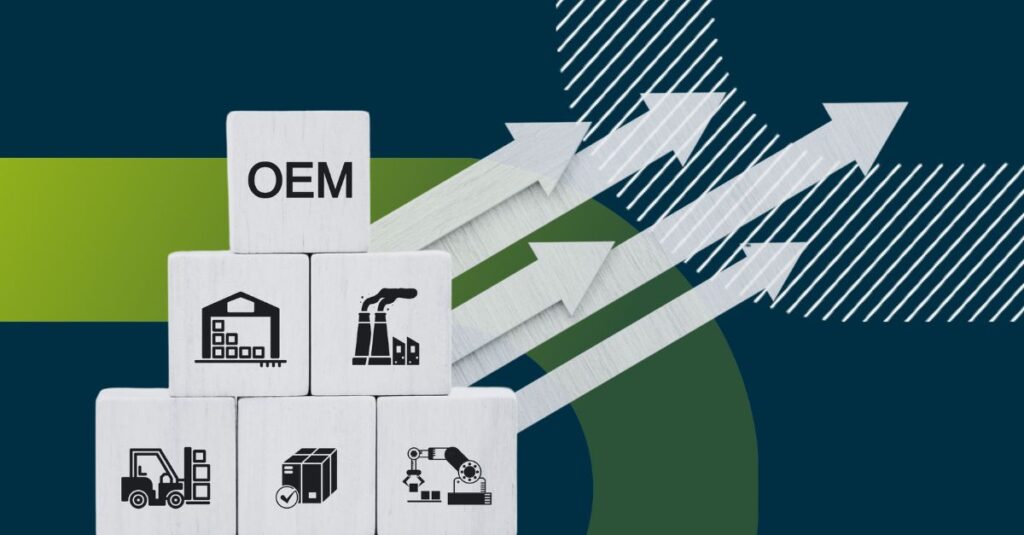In the rapidly changing landscape of mechanical engineering, Original Equipment Manufacturers (OEMs) face significant challenges. The traditional product sales model is reaching its limits: hesitant customer investment and declining order volumes are forcing the industry to rethink its strategies. However, an innovative solution is emerging: through servitization, OEMs are expanding their product offerings with complementary services to build long-term customer relationships and generate recurring revenue.
Inhaltsverzeichnis
The Challenges of Traditional Business Models
Traditional business models tie OEMs to lengthy time-to-market cycles, offer a suboptimal customer experience, and make it difficult to stand out in a highly competitive market. The result is often short-term customer relationships and rigid pricing models that lack flexibility and personalization.
Servitization as a Solution
The answer to these challenges lies in transforming into service-oriented business models such as Equipment-as-a-Service (EaaS), Machine-as-a-Service (MaaS), or Software-as-a-Service (SaaS). These modern models allow customers to use machinery, equipment, or digital services without owning them. This lowers the barriers to initial investment and enables flexible payment models based on usage or achieved results. While EaaS and MaaS target physical machinery and equipment, SaaS offers the possibility to access software on a usage or subscription basis, increasing flexibility and efficiency for both providers and customers.
The 7 Benefits of Servitization
- Increased customer satisfaction and loyalty: By offering continuous services, OEMs build closer relationships with their customers, leading to higher satisfaction. Customers often seek services directly related to the product, such as installation or maintenance. These services provide an excellent opportunity to deepen relationships as suppliers better understand customer needs through frequent contact.
- Steady revenue streams: Regular income from subscriptions or usage fees stabilizes the business, compared to traditional product sales, which can be volatile. Services smooth out revenue streams and stabilize cash flow.
- Differentiation in the market: Offering unique service models allows companies to stand out from the competition and gain a clear competitive advantage. Innovative services create unique selling points that are difficult to replicate.
- Avoiding price competition: Industrialized countries cannot afford price wars with competitors from emerging markets. However, through services, they can offer added value and maintain their market position.
- Higher company value: Companies with stable, recurring revenue are often valued higher than those relying on one-off sales. Additional services open up new opportunities for product growth and expansion.
- Excluding competitors: Services help companies lock out competitors more effectively than physical goods. Services are often deeply integrated into the customer’s internal processes, making them harder to replace.
- Environmental protection: Some servitization services, such as energy or fleet management, help reduce environmental damage or minimize raw material and energy consumption.
Smart Equipment Manufacturing in the Context of Servitization
Smart Equipment Manufacturing refers to the production of machinery and equipment enhanced by advanced technologies like IoT (Internet of Things), Artificial Intelligence (AI), and data analytics. These devices continuously collect and analyze data, enabling predictive maintenance and maximizing uptime. OEMs that manufacture smart equipment can particularly benefit from servitization. By integrating intelligent features and data analysis, they can offer not only the physical product but also valuable services such as maintenance, monitoring, and optimization to their customers.
SKIDATA: Breaking New Ground with Parking-as-a-Service
SKIDATA, a leading provider of access solutions and parking management, has successfully implemented a Parking-as-a-Service model that offers customers a comprehensive package. Under this model, customers pay a fixed monthly fee per entry and exit lane. The package includes both on-premise and cloud-based parking management software, along with the required IT hardware, such as Windows server licenses. Regular upgrades, updates, and technical support are also included, providing customers with a flexible, usage-based solution that eliminates the need for large infrastructure investments.
Servitization and the Limits of ERP Systems
Most companies use ERP (Enterprise Resource Planning) systems for billing, which has been sufficient for traditional business models. ERP systems are designed to integrate the various areas and data within a company to optimize processes and efficiently plan resources. However, for innovative digital business models with complex, usage-based billing requirements, traditional ERP systems are often too rigid. These models require flexible and scalable pricing systems that ERP systems cannot support without significant customization. This limitation can be problematic, particularly for fast-growing companies or those with rapidly changing customer bases. The solution lies in complementing ERP systems with specialized monetization and billing software designed for these needs.
Usage-based business models generate large volumes of real-time data that need to be securely processed and converted into billable units. Traditional ERP systems are often not equipped to handle these data volumes, leading to compliance issues and security risks. Specialized billing systems, on the other hand, can manage these challenges, providing accurate and flexible billing that meets the demands of modern business models. These systems increase efficiency, ensure security, and ultimately lead to higher customer satisfaction.
Conclusion: Achieving Sustainable Growth for OEMs through Servitization and Modern Billing Systems
Transforming to a servitization model offers not only a way to address current market challenges but also a strategic opportunity to future-proof your business. By understanding and implementing servitization, you can diversify your offerings, strengthen relationships with your customers, and secure your market share in a changing industrial landscape. It is essential to recognize that traditional ERP systems are often insufficient to meet the needs of modern business models. Companies should invest in specialized billing solutions that offer flexibility, data security, and the ability to handle large volumes of data to ensure long-term success.
